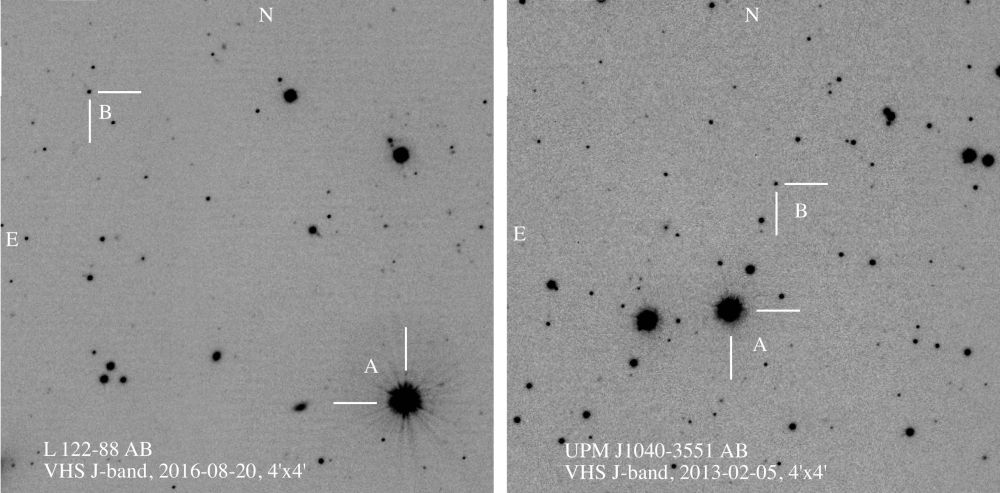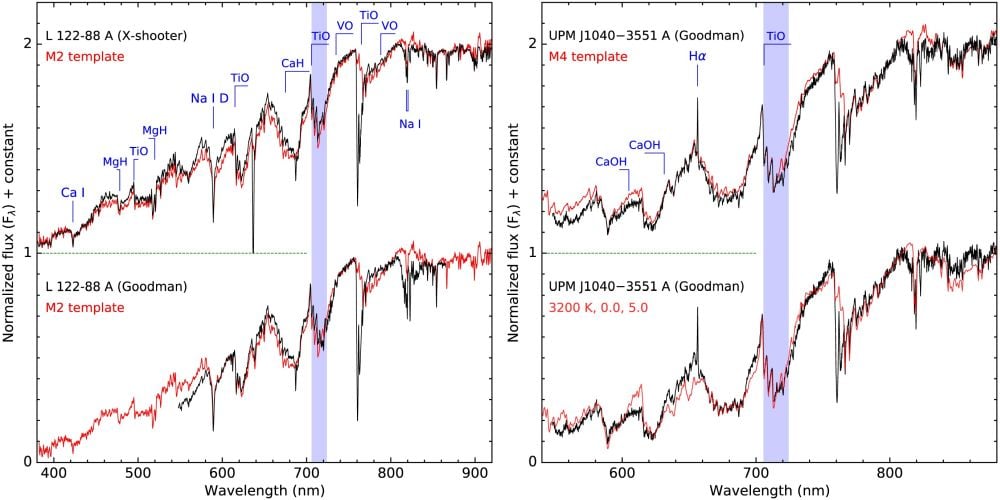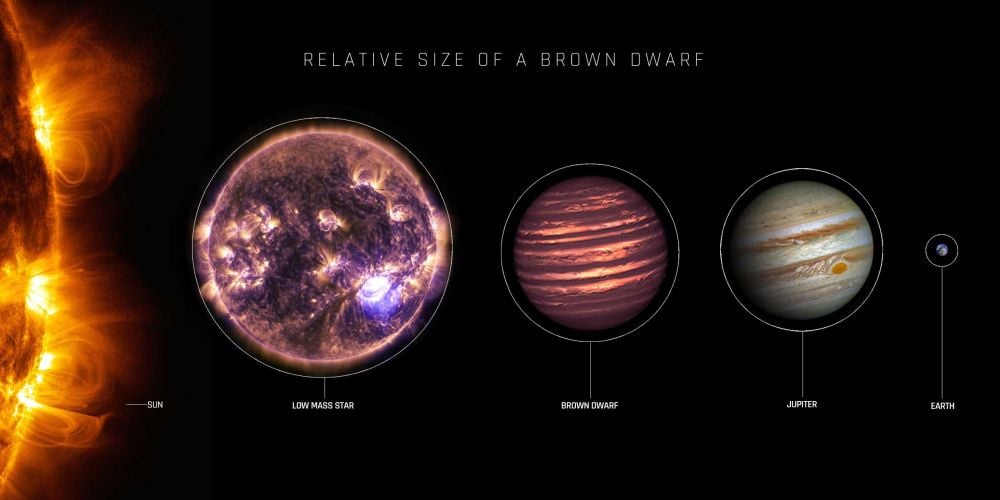There are things astrophysicists know and things they don't know about brown dwarfs. They know that as they were forming and accreting mass, they failed to gain enough mass to trigger hydrogen fusion and become stars. But they're too massive to be gas giant planets like Jupiter because they do fuse some deuterium. So brown dwarfs are stuck in an astrophysical no-man's-land between star and planet. They're often referred to as 'failed stars'.
Because they're so cool and so dim, brown dwarfs difficult to study. Another avenue of understanding opens up when brown dwarfs are in proximity to other stars. That's why the discovery of a rare quadruple star system containing a binary pair of M dwarfs and a binary pair of brown dwarfs 82 light-years away is so significant. It provides a way around the "mass-degeneracy problem".
The mass degeneracy problem explains a fundamental obstacle in observing and understanding brown dwarfs. Brown dwarfs have a strange characteristic: regardless of their mass, their radius stays roughly the same. That's because they're supported by electron degeneracy pressure like white dwarfs are, rather than by thermal pressure like main sequence stars.
They're also unlike main sequence stars in other ways. Since they're not undergoing fusion, they cool down over time. This changes their observable properties, like luminosity, temperature, and spectra.
When astrophysicists observe a single, isolated brown dwarf, they can't be certain what they're seeing. Measuring its temperature can't differentiate between an older, massive object, or a younger, less massive object. The discovery of the quadruple star system and an additional binary pair is giving astrophysicists a new benchmark. Each of the groups has brown dwarf star(s) on wide orbits.
The discovery is presented in a new research article titled "Benchmark brown dwarfs – I. A blue M2 + T5 wide binary and a probable young [M4 + M4] + [T7 + T8] hierarchical quadruple." It's published in the Monthly Notices of the Royal Astronomical Society, and the lead author is Professor Zenghua Zhang of Nanjing University in China.
"L 122–88 AB is a wide binary comprising a mildly metal-poor M2 dwarf and a T5 dwarf," the authors explain, while "UPM J1040–3551 AB is a candidate hierarchical quadruple system," containing a pair of M dwarfs and a pair of brown dwarfs.
 These are images from the Visible and Infrared Survey Telescope for Astronomy (VISTA) showing both systems. The left panel shows L 122–88 AB (left panel) and the quadruple system UPM J1040–3551 AB in the right panel. Image Credit: Zhang et al. 2025. MNRAS
These are images from the Visible and Infrared Survey Telescope for Astronomy (VISTA) showing both systems. The left panel shows L 122–88 AB (left panel) and the quadruple system UPM J1040–3551 AB in the right panel. Image Credit: Zhang et al. 2025. MNRAS
"Benchmark brown dwarfs in wide binary systems are crucial for characterizing substellar objects and calibrating atmospheric and evolutionary models," the authors write in their article. "However, brown dwarf benchmarks with subsolar metallicity, very cool temperatures, or suitability for dynamical mass measurements are rare, limiting our understanding across the full range of mass, age, and metallicity."
The quadruple system UPM J1040−3551 AabBab has a cumbersome name. Aab is the brighter pair consisting of Aa and Ab, both red dwarfs. Bab is the dimmer pair consisting of Ba and Bb, both brown dwarfs. The quadruple star system was discovered with data from the ESA's Gaia mission and NASA's Wide-field Infrared Explorer. The researchers followed up with spectroscopic observations.
"What makes this discovery particularly exciting is the hierarchical nature of the system, which is required for its orbit to remain stable over a long time period," lead author Zhang said in a press release. "These two pairs of objects are orbiting each other separately for periods of decades, while the pairs are also orbiting a common centre of mass over a period of more than 100,000 years."
1,656 astronomical units (au) separate the two pairs. The visual magnitude of the red dwarf pair is only 14.6, meaning they're extremely dim, 100,000 times dimmer in visual light than the North Star, Polaris. Bab, the pair of even fainter brown dwarfs, emit almost no visible light. They're only sensed in the near-infrared, where they're 1,000 times dimmer than the red dwarf pair.
Wobbling detected by Gaia revealed the presence of the red dwarf pair Aab, and the unusual brightness confirmed it. It was about 0.7 magnitude brighter than a single star with the same temperature at the same distance. A binary pair of stars with almost equal masses essentially doubles their brightness.
A similar thing happened with the brown dwarf pair, Bab. It was unusually bright for a single brown dwarf of its type. Spectral analysis also supported the idea that it's a binary pair.
Co-author Dr. Felipe Navarete from the Brazilian National Astrophysics Laboratory led the spectroscopic observations that helped determine what they were seeing. He worked with the Southern Astrophysical Research (SOAR) Telescope at Cerro Tololo Inter-American Observatory in Chile to obtain spectra of both pairs of stars.
 These panels compare the optical spectra of L 122–88 A (left panel) and UPM J1040–3551 A (right panel) with M2 and M4 templates, types of red dwarf stars, respectively. L 122–88 A closely matches an M2 dwarf, while UPM J1040–3551 A closely matches that of an M4 dwarf. Image Credit: Zhang et al. 2025. MNRAS
These panels compare the optical spectra of L 122–88 A (left panel) and UPM J1040–3551 A (right panel) with M2 and M4 templates, types of red dwarf stars, respectively. L 122–88 A closely matches an M2 dwarf, while UPM J1040–3551 A closely matches that of an M4 dwarf. Image Credit: Zhang et al. 2025. MNRAS
"These observations were challenging due to the faintness of the brown dwarfs," said Dr Navarete, "but the capabilities of SOAR allowed us to collect the crucial spectroscopic data needed to understand the nature of these objects."
The researchers determined that the red dwarf pair are each about 17% as massive as the Sun with temperatures of approximately 2,900 Celsius. The brown dwarf pair are T-type brown dwarfs with temperatures of 550°C and 420°C. The brown dwarfs are similar in size to Jupiter, but are much denser. Their masses are between 10 and 30 times greater than Jupiter's.
"This is the first quadruple system ever discovered with a pair of T-type brown dwarfs orbiting two stars," said Dr MariCruz Gálvez-Ortiz of the Center for Astrobiology in Spain, a co-author of the research paper. "The discovery provides a unique cosmic laboratory for studying these mysterious objects."
It's these observations and measurements that provide a way forward past the mass degeneracy problem. It's because in the quadruple system, all of the stars formed from the same molecular cloud at the same time. They have the same age and metallicity.
 This image shows the relative sizes of the Sun, a low mass star, a brown dwarf, Jupiter, and the Earth. Image Credit: Jupiter: NASA, ESA, and A. Simon (NASA, GSFC). Sun and Low-Mass Star: NASA, SDO. Brown Dwarf: NASA, ESA, and JPL-Caltech. Earth: NASA. Infographic: NASA and E. Wheatley (STScI).
This image shows the relative sizes of the Sun, a low mass star, a brown dwarf, Jupiter, and the Earth. Image Credit: Jupiter: NASA, ESA, and A. Simon (NASA, GSFC). Sun and Low-Mass Star: NASA, SDO. Brown Dwarf: NASA, ESA, and JPL-Caltech. Earth: NASA. Infographic: NASA and E. Wheatley (STScI).
"Brown dwarfs with wide stellar companions whose ages can be determined independently are invaluable at breaking this degeneracy as age benchmarks," explained co-author Professor Hugh Jones of the University of Hertfordshire. "UPM J1040−3551 is particularly valuable because H-alpha emission from the brighter pair indicates the system is relatively young, between 300 million and 2 billion years old."
The study of brown dwarfs has been hampered by a circular dependency that uses luminosity to determine mass and age simultaneously. But now that the researchers have measured H-alpha emissions, they can estimate ages based on stellar activity rather than models.
The other way this research helps with the mass degeneracy problem is because the brown dwarfs are on wide orbits around primary M dwarfs with well-characterized properties. The large distance separating removes the contaminating effects of tidal heating that could alter the cooling history of the brown dwarfs. It also eliminates the potential for mass transfer and orbital decay, which could also create confusion.
"This system offers a dual benefit for brown dwarf science," said co-researcher Professor Adam Burgasser of the University of California San Diego. "It can serve as an age benchmark to calibrate low-temperature atmosphere models, and as a mass benchmark to test evolutionary models if we can resolve the brown dwarf binary and track its orbit."
"These newly discovered systems, L 122–88 AB and UPM J1040–3551 AB, augment the sample of benchmark BDs, particularly in the less-explored regimes of cool temperature," the researchers write in their article.
"Furthermore, these systems may provide crucial insights into bridging the gap between BDs and giant exoplanets, contributing to a more comprehensive understanding of the low-mass end of the stellar–substellar–planetary continuum," they conclude.

